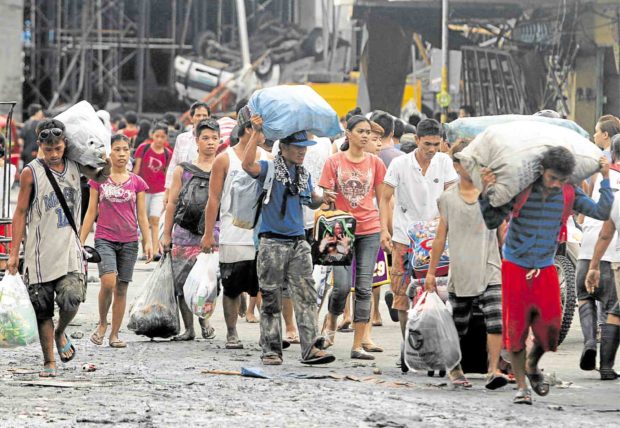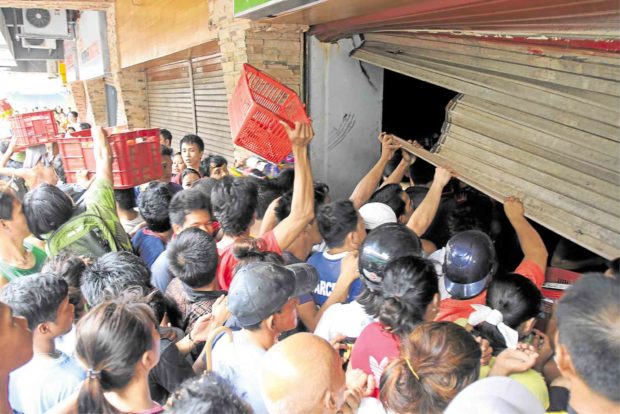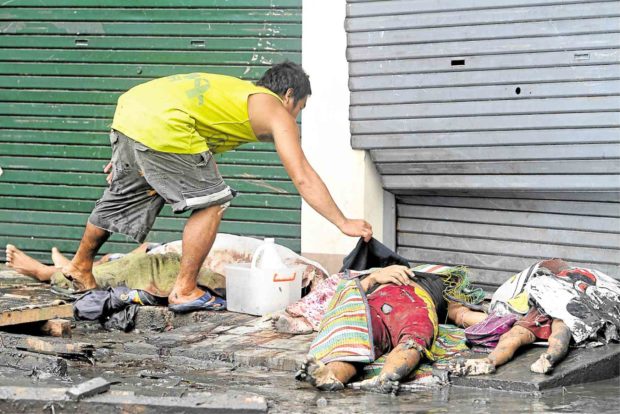Descent into chaos
When Inquirer photographer Niño Jesus Orbeta learned that he and reporter DJ Yap were covering “Yolanda,” a category 5 supertyphoon forecast to hit Tacloban with full force the following day, he immediately dredged up some tips born of his experiences as a Bicol native used to the onslaught of typhoons and storms.
“Let’s not go near the sea,” he cautioned Yap. “I know how storms move, how the Pacific (Ocean) behaves.
Surrounded by water, Tacloban has no escape route, he said, adding that it was wedged between Cancabato Bay and the Tacloban Bay. It was also flatland, with nowhere to hide should the waters rise.
“We must look for a solid building,” he told Yap and felt thankful when they were offered a room on the fourth floor of an otherwise fully booked hotel. Later, as people swarmed the upper floors of the hotel to escape the rapidly rising waters, he could hear the fear and panic in their voices.
“There was general commotion,” he recalled.
Article continues after this advertisement“Safety first” has been a mantra for Orbeta who was understandably bothered when he saw Tacloban residents being complacent just hours before Yolanda hit.
Article continues after this advertisement“People were drinking in the streets, and were even asking us to join them,” he said, shaking his head. It’s very different in Albay, Orbeta said, adding that two days before an expected storm, people would be streaming into evacuation centers and hunkering down with their relief goods.
Complacency
“We learned from ‘Reming,’” he said, referring to the violent tropical cyclone in November 2006 whose 195 kilometers per hour winds and mudflows from Mayon Volcano caused massive damage and the loss of at least 1,500 lives.
But things remained calm in Tacloban that eve of Yolanda, with one habal-habal (tricycle) driver gloating that the typhoon wouldn’t touch Tacloban, but would instead head towards Mindanao. Sure, storms also visit the province, but they only bring in knee-high waters, the driver said confidently, recounted Orbeta.
He decided not to argue but asked the driver to take him to the province’s prominent landmarks so he could take “before” and “after” photos for the Inquirer.
But more disturbing than the people’s complacency in the face of certain calamity was the descent into chaos after Yolanda hit, he said.
“There was sheer lawlessness. Walang batas,” Orbeta said. “People in SUVs were breaking into stores and carting off flat TVs. Rich people joined the mob, even little boys of kindergarten age were looting, nakikisabay sa matatanda. (They all got carried away),” he said.
The Chinese owner of the hotel they had stayed in told him: “Sir, people are hungry. Pag hinoldap ka, just give your stuff so you don’t get hurt.”
But you wonder if it was just desperation, the photographer said, adding that it was like the tragedy brought out the criminal in people.
“I saw this group of young men dragging an ATM (automated teller machine) across the road and trying to hack it open. I raised my camera to take a picture but this boy looked up and pointed a hostile finger at me. I feared that on his word, they would start lynching me. I bowed my head and put down my camera. Hindi ko yun teritoryo.”

EXODUS “Yolanda” survivors carry whatever they could salvage from the ruins of their home as they stream out of the flattened city. —PHOTOS BY NIÑO JESUS ORBETA
Two months later, Orbeta went back to Tacloban and asked how Yolanda had affected the people. One tricycle driver said darkly: “Tinuruan kami ng ‘Yolanda’ na magnakaw (Yolanda taught us to steal).”
Niño Jesus Orbeta started as a Bicol correspondent in 2003 and became a regular Inquirer photographer in 2009.

